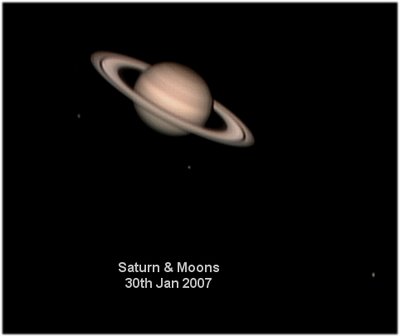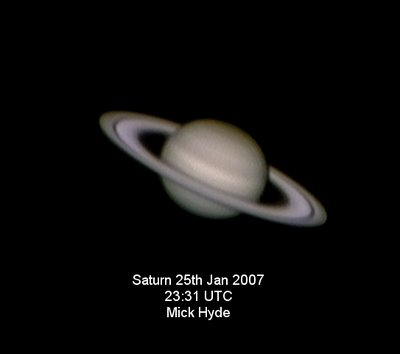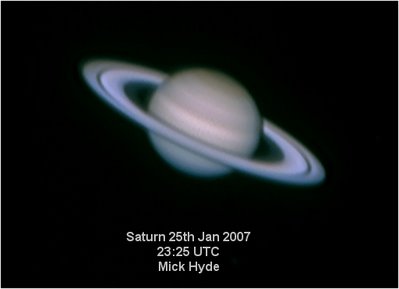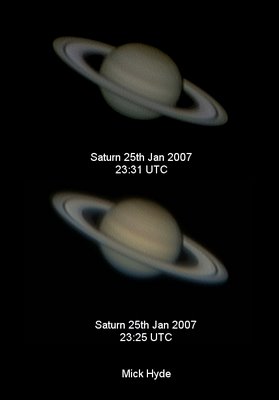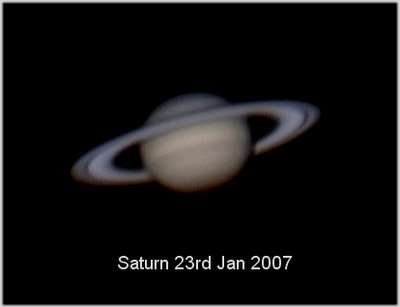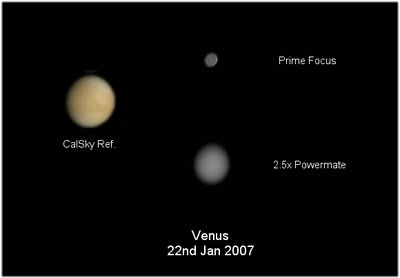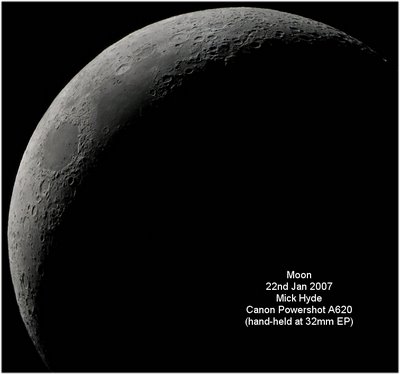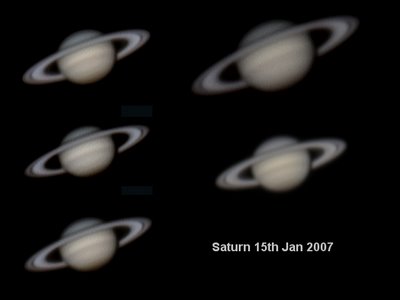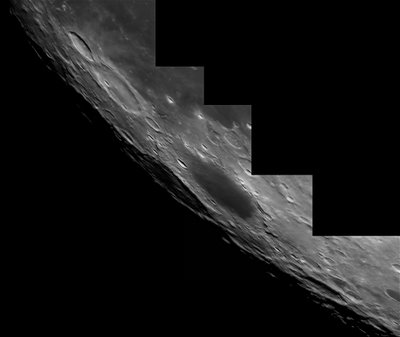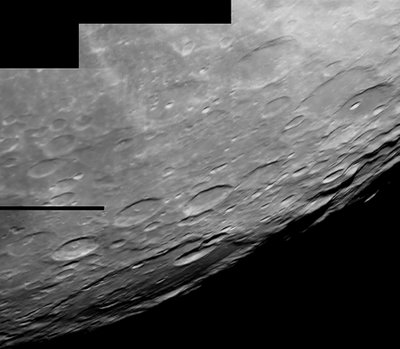 Venus tonight from my back garden.
Venus tonight from my back garden.
Wednesday, January 31, 2007
Tuesday, January 30, 2007
Mars re-processed from 2005.
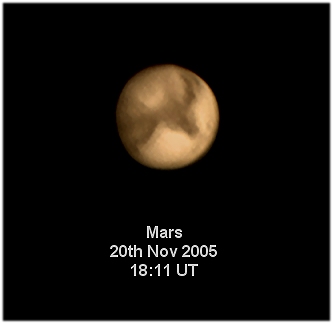
Mars re-processed from the year before last... can you believe it? Using new techniques.
Looking back in the archives.
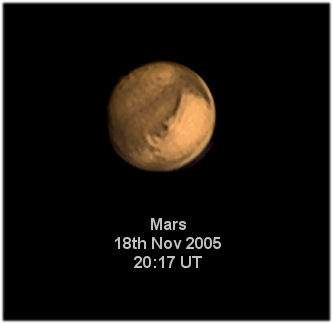
Monday, January 29, 2007
The Apennines 27th Jan 2007
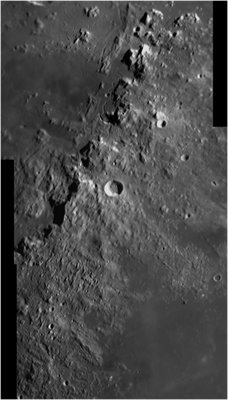 Montes Apenninus are a rugged mountain range on the northern part of the Moon's near side. They named for the Apennine Mountains in Italy.
Montes Apenninus are a rugged mountain range on the northern part of the Moon's near side. They named for the Apennine Mountains in Italy.This range forms the southeastern border of the large Mare Imbrium lunar mare. It begins just to the west of the prominent Eratosthenes crater, which is abutted against the southern face of the range. To the west of these mountains is a narrow gap where Mare Imbrium in the north joins Mare Insularum to the south. Further to the west are the Montes Carpatus mountains.
From Eratosthenes, the mountains form an arcing chain that gradually bends from east to northeast, ending at Promontorium Fresnel at about latitude 29.5° N. Here is another gap where the Mare Imbrium to the west joins the Mare Serenitatis to the east. At the north end of this gap lie the Montes Caucasus.
Wikipedia
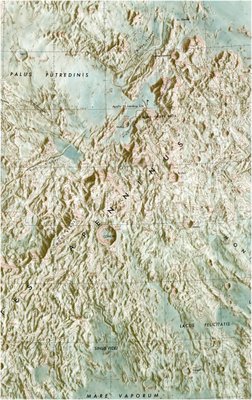 Map from LPI.
Map from LPI.
Sunday, January 28, 2007
Theophilus 25th Jan 2007
 Theophilus is a prominent lunar impact crater that lies between Sinus Asperitatis in the north and Mare Nectaris to the southeast. It partially intrudes into the comparably-sized Cyrillus crater to the southwest. To the east is the smaller Mädler crater and further to the south-southeast is Beaumont crater. To the west-northwest is Mons Penck, a peak forming a promontory arm on the Rupes Altai.
Theophilus is a prominent lunar impact crater that lies between Sinus Asperitatis in the north and Mare Nectaris to the southeast. It partially intrudes into the comparably-sized Cyrillus crater to the southwest. To the east is the smaller Mädler crater and further to the south-southeast is Beaumont crater. To the west-northwest is Mons Penck, a peak forming a promontory arm on the Rupes Altai.The Rev. T. W. Webb described this as "the deepest of all visible craters". The rim of Theophilus crater has a wide, terraced inner surface that shows indications of landslips. The exterior has a wide, wrinkled rampart that descends about 1.4 kilometers to the surrounding maria. The largest impact crater of significance on the wall is the small Theophilus B on the inside of the northwest rim. Most of the rays from this crater have been weathered away, although a few are still visible.
The floor of the crater is relatively flat, and it has a large, triple-peaked central crater that climbs to a height of about 2 kilometers above the floor. The western peak is designated Psi (ψ), the eastern Phi (φ), and the northern peak is Alpha (α) Theophilus. The western slopes of this ridge are wider and more irregular, whereas the peaks descend more sharply to the floor on the northern and western faces.
The Apollo 16 mission collected several pieces of basalt that are believed to be ejecta from the formation of the Theophilus crater.
Wikipedia
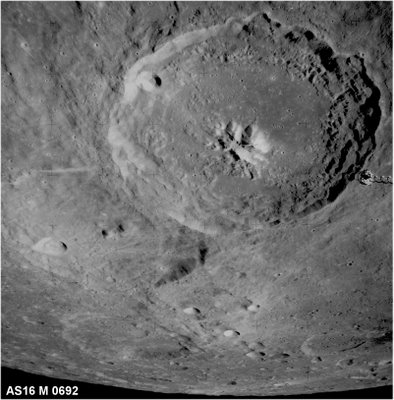 Apollo 16 Mapping camera.
Apollo 16 Mapping camera.
Saturday, January 27, 2007
Saturn & Titan 27th Jan 2007
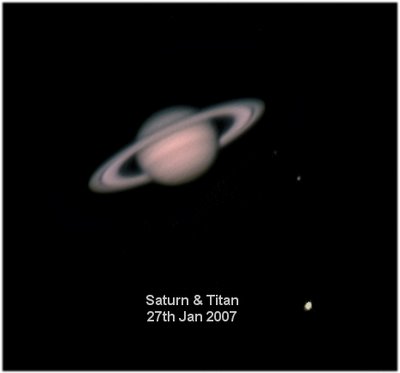
Titan (tye'-t?n, IPA: ['ta?tn?], Greek ??t??) or Saturn VI is the largest moon of Saturn and the second largest moon in the solar system, after Jupiter's moon Ganymede. It is roughly 50% larger than Earth's moon by diameter, and is larger by diameter and mass than all known dwarf planets. It is also larger by diameter than the planet Mercury, though Mercury is more than twice as massive.
Titan is the only moon in our solar system to have a dense atmosphere. Until very recently, this atmosphere inhibited understanding of Titan's surface, but the moon is currently undergoing study by the Cassini-Huygens mission, and new information about it is accumulating, such as the discovery of liquid hydrocarbon lakes near its north pole.
Titan was discovered on March 25, 1655 by the Dutch astronomer Christiaan Huygens, and was the first moon in the Solar System to be discovered after the Galilean moons of Jupiter.
Wikipedia
Pitatus and the Alpine Valley 27th Jan 2007
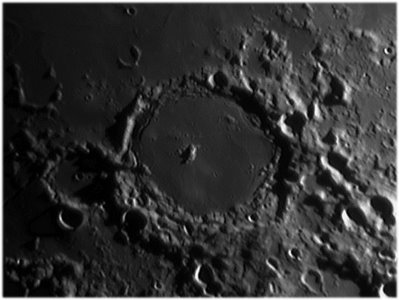 Pitatus is an ancient lunar impact crater located at the southern edge of Mare Nubium. Joined to the northwest rim is Hesiodus crater, and the two are joined by a narrow cleft. To the south lie the attached Wurzelbauer and Gauricus craters.
Pitatus is an ancient lunar impact crater located at the southern edge of Mare Nubium. Joined to the northwest rim is Hesiodus crater, and the two are joined by a narrow cleft. To the south lie the attached Wurzelbauer and Gauricus craters.The complex wall of Pitatus is heavily worn, and has been encroached by lava flows. The rim is lowest to the north, where the lava almost joins the Mare Imbrium. Near the middle is a low central peak that is offset to the northwest of center. This peak only rises to a height of 0.5 km.
Pitatus is a floor-fractured crater, meaning it was flooded from the interior by magma intrusion through cracks and openings. (See also the Gassendi and Posidonius craters for similar features.) The flooded crater floor contains low hills in the east and a system of slender clefts named the Rimae Pitatus. The larger and more spectacular of these rilles follow the edges of the inner walls, especially in the northern and eastern halves. The floor also contains the faint traces of deposited ray markings.
Just to the north of Pitatus in the neighboring maria is the half-buried rim of a lesser crater, covered in the past when Mare Nubium was formed.
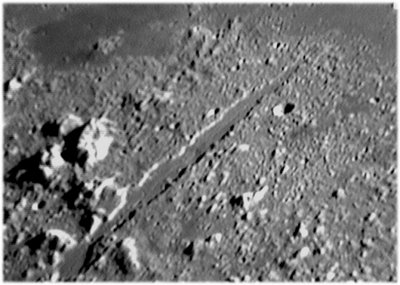 Vallis Alpes (latin for"Alpine Valley") is a spectacular lunar valley feature that bisects the Montes Alpes range. It extends 166 km from the Mare Imbrium basin, trending east-northeast to the edge of the Mare Frigoris. The valley is narrow at both ends and widens to a maximum width of about 10 km along the middle stretch. The selenographic coordinates of this feature are 48.5° N 3.2° E.
Vallis Alpes (latin for"Alpine Valley") is a spectacular lunar valley feature that bisects the Montes Alpes range. It extends 166 km from the Mare Imbrium basin, trending east-northeast to the edge of the Mare Frigoris. The valley is narrow at both ends and widens to a maximum width of about 10 km along the middle stretch. The selenographic coordinates of this feature are 48.5° N 3.2° E.The valley floor is a flat, lava-flooded surface that is bisected by a slender, cleft-like rille. (This cleft is a challenging target for telescope observation from the Earth.) The sides of the valley rise from the floor to the surrounding highland terrain, a blocky, irregular surface. The southern face of the valley is straighter than the northern side, which is slightly bowed and uneven. The more rugged edges of the valley lie at the narrow west-southwest end that cuts through the mountain range. Most likely this valley is a graben that was subsequently flooded with magma.
This valley was discovered in 1727 by Francesco Bianchini.
The Straight Wall (Rupes Recta) 27th Jan 2007
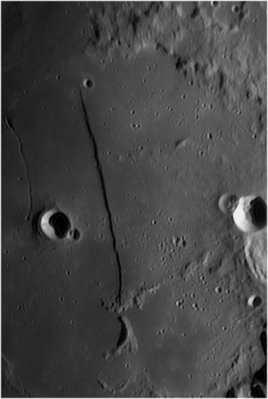 Rupes Recta is a linear fault on the Moon, in the southeastern part of the Mare Nubium. The name is latin for "Straight Fault", although it is more commonly called the Straight Wall. This is the most well-known escarpment feature on the Moon, and is a popular target for amateur astronomers.
Rupes Recta is a linear fault on the Moon, in the southeastern part of the Mare Nubium. The name is latin for "Straight Fault", although it is more commonly called the Straight Wall. This is the most well-known escarpment feature on the Moon, and is a popular target for amateur astronomers.When the sun illuminates the feature at an oblique angle at about day 8 of the lunar orbit, the Rupes Recta casts a wide shadow that gives it the appearance of a steep cliff. The fault has a length of 110 km, a typical width of 2-3 km, and a height of 240-300 m. Thus although it appears to be a vertical cliff in the lunar surface, in actuality the grade of the slope is relatively shallow.
To the west of this escarpment is the Birt crater, which is about 10.5 miles in diameter. Also to the west is the Rima Birt rille. At the southern end is a group of hills often called the "Stag's-Horn Mountains", although this name is not officially recognized by the IAU.
Wikipedia
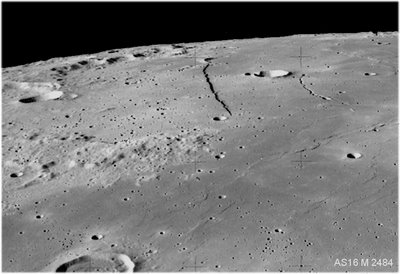 Oblique view from Apollo 16 mapping camera.
Oblique view from Apollo 16 mapping camera.
Ptolemaeus big mosaic 27th Jan 2007
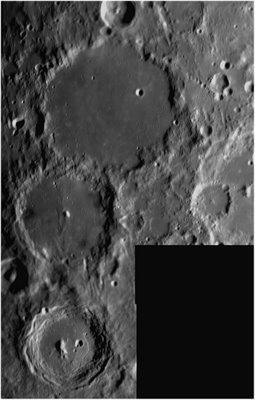 Ptolemaeus is an ancient lunar impact crater close to the center of the near side. To the south-southeast Ptolemaeus is joined to the rim of Alphonsus crater by a section of rugged, irregular terrain, and these form a prominent chain with Arzachel to the south. To the southeast is Albategnius crater and to the north is the smaller but well-defined Herschel crater.
Ptolemaeus is an ancient lunar impact crater close to the center of the near side. To the south-southeast Ptolemaeus is joined to the rim of Alphonsus crater by a section of rugged, irregular terrain, and these form a prominent chain with Arzachel to the south. To the southeast is Albategnius crater and to the north is the smaller but well-defined Herschel crater.The features of Ptolemaeus are highlighted when the sun is at low angles during the first and last quarter. During the full moon the sun is directly overhead and the crater contours become more difficult to discern.
The crater has a low, irregular outer rim that is heavily worn and impacted with multiple smaller craters. The rim has a discernable polygonal shape, although overall it remains circular. The largest of the peaks along the rim, designated Ptolemaeus Gamma (γ), has an altitude of 2.9km and is located along the northwest rim. The crater has no central peak, a lava-flooded floor, and lacks a ray system. Impact sites of this form are often classified as a "walled-plain", due to their resemblance to the maria.
The somewhat dark-hued floor of Ptolemaeus is notable for several "ghost" craters, formed when lava flow covers a pre-existing crater. These leave only a slight rise where the rim existed, and are difficult to detect except at low angles of sunlight. There are also multiple smaller craters across the floor surface, most notably Ammonius crater in the northeastern quadrant.
On either of this crater are a linear, irregular gashes in the lunar surface, forming valley-like features. These features are approximately parallel to each other and radiate from the direction of Mare Imbrium to the north-northwest.
Wikipedia
 Here's a great view by Apollo 12, taken on the right of the crater, looking across it to the West.
Here's a great view by Apollo 12, taken on the right of the crater, looking across it to the West.
Posidonius to Littrow
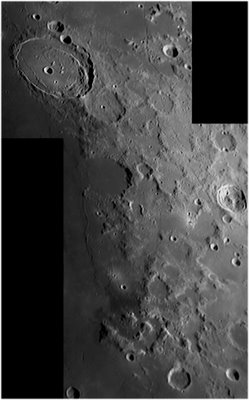 Posidonius is a lunar impact crater that is located on the western edge of Mare Serenitatis, to the south of Lacus Somniorum. The Chacornac crater is attached to the southeast rim, and to the north is Daniell crater.
Posidonius is a lunar impact crater that is located on the western edge of Mare Serenitatis, to the south of Lacus Somniorum. The Chacornac crater is attached to the southeast rim, and to the north is Daniell crater.The rim of Posidonius is shallow and obscured, especially on the western edge, and the interior has been overlaid by a lava flow in the past. The crater ramparts can still be observed to the south and east of the crater rim, and to a lesser degree to the north.
There is a smaller, semi-circular rim of a concentric, flooded crater within the main rim, offset toward the eastern edge. There is no central peak, but the floor is hilly and laced with a rille system named the Rimae Posidonius. The floor is also slightly bulged due to the past lava uplift, which also likely produced the complex of rilles. The northeast rim is interrupted by the smaller crater 'Posidonius B'. Within the crater rim, offset just to the west of center is another smaller crater 'Posidonius A'.
On the Mare Serenitatis surface near Posidonius crater is a notable system of wrinkle-ridges that parallel the nearby shore. These are designated the Dorsa Smirnov. At the peak of these ridges is a small craterlet with a diameter of 2 km. This craterlet is surrounded by a patch of high-albedo material, and is an example of a lunar bright spot. This peak was formerly designated Posidonius Gamma (γ).
The Posidonius Gamma feature was first observed by the lunar cartographer Julius Schmidt in 1857. He noted the similarity to the bright patch surrounding Linné crater.
Wikipedia
Friday, January 26, 2007
Thursday, January 25, 2007
Moon from 25th Jan 2007
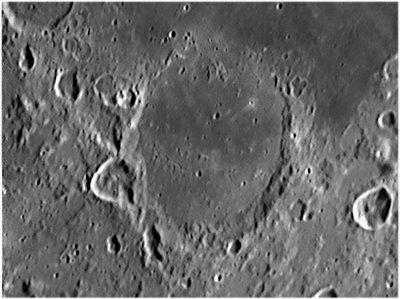 Fracastorius is the lava-flooded remnant of an ancient lunar impact crater located at the southern edge of Mare Nectaris. To the northwest of this formation lies the Beaumont crater, while to the northeast is Rosse.
Fracastorius is the lava-flooded remnant of an ancient lunar impact crater located at the southern edge of Mare Nectaris. To the northwest of this formation lies the Beaumont crater, while to the northeast is Rosse.The northern wall of this crater is missing, with only mounds appearing in the lunar mare to mark the outline. The lava that formed Mare Nectaris also invaded this crater, so the structure now forms a bay-like extension. The remainder of the rim is heavily worn and covered in lesser impact craters, leaving little of the original rim intact. The maximum elevation of the rim is 2.4 km. The most prominent of these craters is 'Fractastorius D', which overlays a portion of the western rim.
The Fracastorius crater has no central peak, but a long, slender rille runs across the middle of the floor in a generally east-west direction.
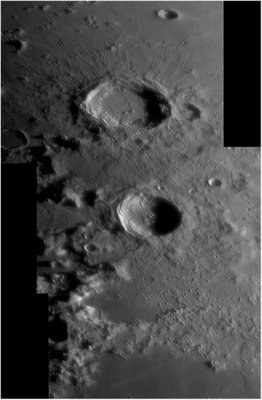 Aristoteles is a lunar impact crater that lies near the southern edge of the Mare Frigoris, and to the east of the Montes Alpes mountain range. To the south of Aristoteles lies the slightly smaller crater Eudoxus, and these two form a distinctive pair for a telescope observer. An arc of mountains between these craters bends to the west, before joining the walls. The smaller Mitchell crater is directly attached to the eastern rim of Aristoteles. To the west is the low, flooded Egede crater.
Aristoteles is a lunar impact crater that lies near the southern edge of the Mare Frigoris, and to the east of the Montes Alpes mountain range. To the south of Aristoteles lies the slightly smaller crater Eudoxus, and these two form a distinctive pair for a telescope observer. An arc of mountains between these craters bends to the west, before joining the walls. The smaller Mitchell crater is directly attached to the eastern rim of Aristoteles. To the west is the low, flooded Egede crater.Observers have noted the crater wall of Aristoteles is slightly distorted into a rounded hexagon shape. The inner walls are wide and finely terraced. The outer ramparts display a generally radial structure of hillocks through the extensive blanket of ejecta. The crater floor is uneven, and covered in hilly ripples. Aristoteles does possess central peaks, but they are somewhat offset to the south. wikipedia
3 image mosaic, using 2.5x Powermate and IR pass filter.
Tuesday, January 23, 2007
Monday, January 22, 2007
Monday, January 15, 2007
Sunday, January 07, 2007
Saturday, January 06, 2007
Moon Halo 5th Jan 2007
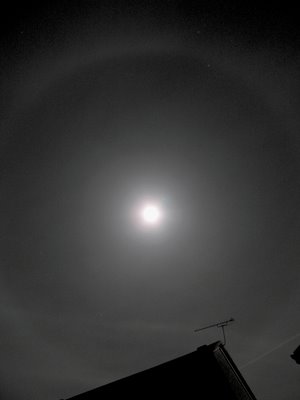 As I was packing up tonight, after another night of rubbish seeing, I noticed a large Moon Halo. Now I know why the seeing was bad... all those ice crystals in the air making a nice Moondog :-(
As I was packing up tonight, after another night of rubbish seeing, I noticed a large Moon Halo. Now I know why the seeing was bad... all those ice crystals in the air making a nice Moondog :-(Here's a couple of snaps taken at 13 Sec, F/4.5, with my Canon Powershot A620.

Friday, January 05, 2007
Langrenus 5th Jan 2007
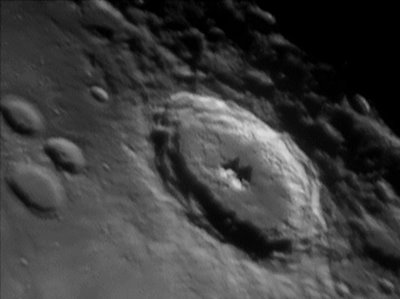 Not very good seeing tonight.
Not very good seeing tonight.Funny, the peak doesn't look like a twin peak, but the shadows give it away.
BTW. they're about a kilometer high.
I didn't see any TLP
Wednesday, January 03, 2007
Monday, January 01, 2007
Subscribe to:
Comments (Atom)




